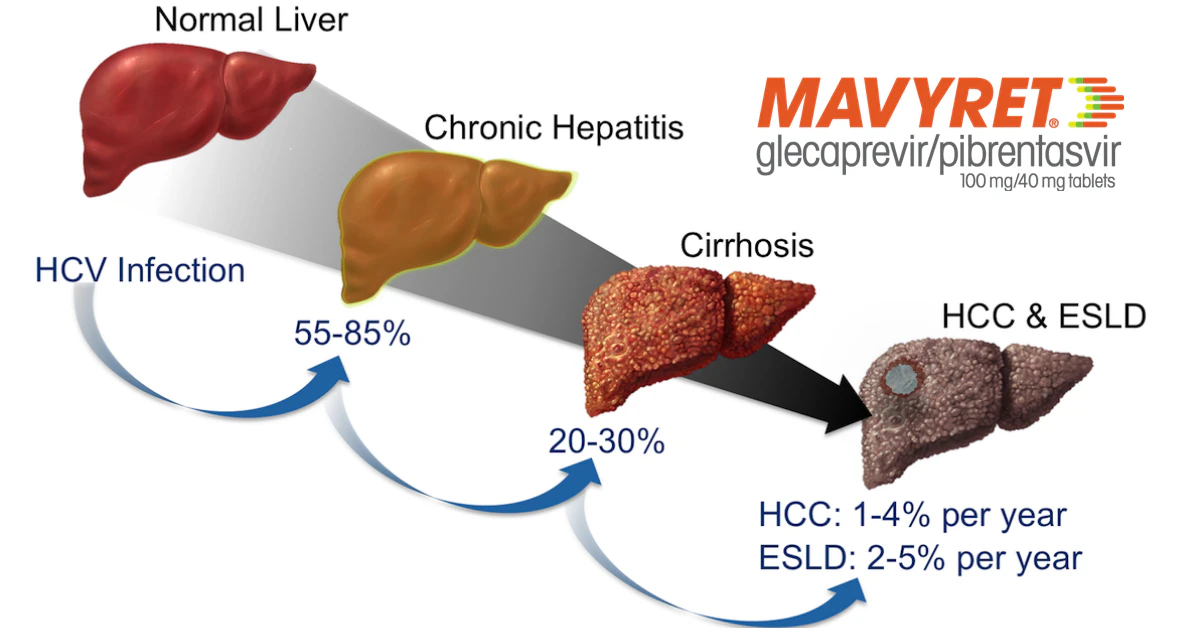Hey there! If you’ve landed on this page, you’re probably wondering exactly what Mavyret does and whether it’s the right fit for you or someone you love. In a nutshell, Mavyret (glecaprevir + pibrentasvir) is an oral, fixed‑dose combo that treats chronic hepatitis C virus (HCV) infection – any genotype from 1 through 6 – in people three years old and up, whether they have no cirrhosis or only compensated cirrhosis. Sound promising? Let’s dive deeper, keep it friendly, and make sure you walk away feeling confident and informed.
Who Can Take
First things first: who is eligible?
Age and Genotype
Mavyret is approved for children (≥ 3 years) and adults. It covers all HCV genotypes (1‑6), so you don’t need a separate test to pick a different pill.
Health‑Status Requirements
- No cirrhosis or compensated cirrhosis (Child‑Pugh A) – the liver is still doing its job, just a bit scarred.
- Not for de‑compensated cirrhosis (Child‑Pugh B/C). Those patients need a different approach.
- If you’ve been treated before, you can still use Mavyret as long as you previously received either an NS5A inhibitor or an NS3/4A protease inhibitor – but not both.
Wondering about cost? Our Mavyret cost guide breaks down pricing, insurance tricks, and patient‑assistance programs.
How It Works
Two‑Target Attack
Think of HCV as a sneaky burglar with two tools: a lock‑picker (NS3/4A protease) and a master key (NS5A protein). Mavyret throws two drugs at the party:
- Glecaprevir – blocks the protease, stopping the virus from cutting its proteins into functional pieces.
- Pibrentasvir – jams the NS5A protein, halting the virus’s replication machinery.
By hitting both targets, the virus can’t easily develop resistance, which explains why cure rates (SVR > 95 %) are so high.
Pharmacology Snapshot
Both ingredients are taken once daily with food. They’re metabolized mainly by CYP3A4, so strong inducers (like rifampin or St John’s wort) can lower their effectiveness. According to the FDA’s DailyMed, the half‑life is roughly 5–6 hours, and steady‑state levels are reached within a few days.
Treatment Regimen
Standard 8‑Week Course
If you’re treatment‑naïve and have no cirrhosis, you’ll likely finish in just eight weeks – that’s two months of a single pill (or pellet) a day. Short, right?
When It Extends
- Previous NS5A‑inhibitor exposure → 16 weeks.
- Previous NS3/4A‑protease inhibitor exposure → 12 weeks.
- Patients with compensated cirrhosis and prior therapy may need 12‑16 weeks depending on the regimen.
Pediatric Dosing
Kids get weight‑based tablets or soft pellets. For exact gram‑for‑gram guidance, check our Mavyret dosing guide. It’s simple: dose scales with body weight, and you still take it once a day with food.
No Generic Yet
As of now, there’s no FDA‑approved generic version. If you’re hunting for a cheaper alternative, stay tuned – we keep the Mavyret generic page updated with any news.
Benefits vs Risks
Why It’s a Win
- High cure rates – >95 % across genotypes, even in tough‑to‑treat populations.
- Short treatment – most finish in 8 weeks.
- Pan‑genotypic – one pill fits all HCV strains.
Common Side Effects
Most folks report mild symptoms that fade as the body gets used to the medication:
- Headache (about 13 % of users)
- Fatigue
- Nausea
- Diarrhea
For a deeper dive, our Mavyret side effects page lists everything from the everyday to the rare.
Serious Safety Alerts
- HBV reactivation – If you ever carried hepatitis B, the virus can flare up during or after treatment. This is a boxed warning on the label. Doctors will test for HBV before you start (HBsAg and anti‑HBc) according to the FDA.
- Liver injury – Rare but possible, especially in patients with existing liver disease.
- Drug interactions – Strong CYP3A4 inducers (e.g., certain anticonvulsants, St John’s wort) can drop drug levels. Check the RxList interaction list before adding new meds.
What to Avoid
We’ve got a handy cheat sheet on that too: what to avoid when taking Mavyret. In short, steer clear of strong enzyme inducers, certain antacids that raise gastric pH, and always keep your doctor in the loop about supplements.
Side Effects After Stopping
Most people feel fine once the course ends. A few report lingering fatigue for a week or two, but there’s no evidence of long‑term organ damage. If symptoms persist beyond a month, it’s wise to get a follow‑up liver panel.
Mavyret vs Others
| Drug | Genotypes Covered | Treatment Length | Pill Burden | Key Interactions | Typical US Cost (2024) |
|---|---|---|---|---|---|
| Mavyret | 1‑6 | 8‑16 weeks | 1 tablet daily (or pellets) | CYP3A4 inducers | $20,000‑$30,000 (list price) |
| Epclusa | 1‑6 | 12 weeks | 2 tablets daily | Fewer CYP issues | $25,000‑$35,000 |
| Viekira Pak | 1‑4 | 12‑24 weeks | 3 tablets daily | Complex interaction profile | $30,000‑$40,000 |
Both Mavyret and Epclusa are pan‑genotypic, but Mavyret’s 8‑week option is a real time‑saver for treatment‑naïve patients. The trade‑off? Slightly more restrictive drug‑interaction rules.
Real‑World Stories
A Clinician’s Perspective
Dr. Lena Morales, a hepatology fellow in Chicago, told me, “When a patient finishes an 8‑week Mavyret regimen and their post‑treatment viral load is undetectable, you see the relief in their eyes. It’s why I recommend it first unless contraindicated.”
Patient Snapshot
Mark, 45, genotype 3, was diagnosed after a routine check‑up. He started Mavyret, took the pill with breakfast, and was back to hiking with his dog after the eighth week. “I felt a little sluggish for the first few days, but the headache went away quickly. The biggest win? Knowing I’m cured in two months instead of twelve.”
Outcomes in the Real World
Large‑scale observational studies (see a study on NCBI) confirm >96 % sustained virologic response across diverse age groups and liver‑status categories, matching clinical‑trial data.
Getting Started
Step 1 – Confirm Diagnosis
Before any prescription, your doctor will order an HCV RNA test and a genotype assay. If you’re unaware of your HBV status, a quick blood test for HBsAg and anti‑HBc is mandatory.
Step 2 – Insurance & Cost Help
Call your insurer, ask about Mavyret coverage, and request prior‑auth. Many manufacturers offer copay‑cards; our cost page walks you through the paperwork.
Step 3 – Pick‑Up & Start
Take the tablet (or pellet) with a meal, same time every day. If you miss a dose, take it as soon as you remember—unless it’s almost time for the next one, then skip the missed dose and continue as normal.
Step 4 – Monitoring
- Baseline labs: ALT, AST, bilirubin, and HBV markers.
- Mid‑treatment labs (optional) to ensure liver enzymes stay stable.
- Post‑treatment SVR test 12 weeks after the last dose to confirm cure.
Step 5 – Follow‑Up Care
Even after a cure, stay on top of liver health—especially if you had cirrhosis. Annual ultrasounds and labs are wise.
Wrap‑Up
So, what is Mavyret used for? It’s a powerful, pan‑genotypic oral regimen that can wipe out chronic hepatitis C in as little as eight weeks, with a safety profile that’s manageable when you’re aware of the key warnings. By understanding who can take it, how it works, the dosing options, and the balance of benefits versus risks, you’re equipped to have a meaningful conversation with your healthcare provider.
Remember, every journey to cure starts with a single question—just like you asked today. If you have more curiosities about dosing, side effects, or cost, explore the linked resources, and never hesitate to talk to a trusted clinician. Here’s to a healthier tomorrow!


















Leave a Reply
You must be logged in to post a comment.